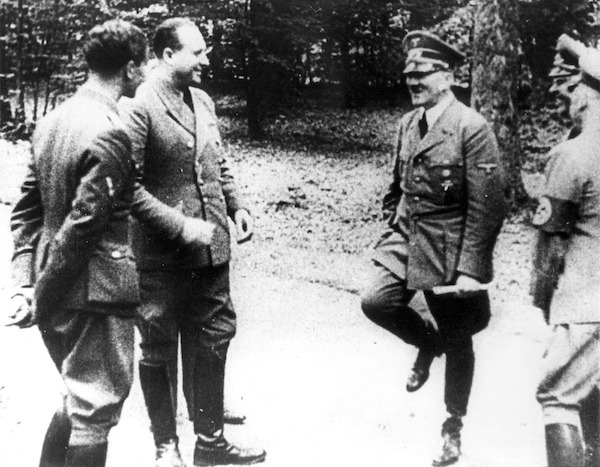Adolf Hitler considered jazz a ‘racially inferior’ form of American black music, and banned it from the airwaves. Germany’s gilded youth flouted the prohibition by playing Duke Ellington in secret and greeting each other loudly in English: ‘Hallo, Old Swing Boy!’ Resistance was useless. The Brownshirts raided parties and even beaches in search of portable wind-up gramophones and gleefully kicked the shellac records to pieces. By 1942, Hitler’s police were arresting up to 50 people a day in Berlin alone.
On learning of Hitler’s death in Berlin in January 1945, however, the Reich Chancellery staff put on jazz records and brought on the dancing girls. If Hitler had won the war, the future would have been millions of blond people reproducing themselves. As specimens of the approved Nazi type (blue eyes, flaxen hair), they would not have liked jazz that much.
Hitler was not the only one who advocated genetic breeding programmes to arrest the multiplication of the ‘unfit’, Norman Stone reminds us. Many British writers and thinkers of the early 1930s dreamed of a samurai class of technocrats who would apply scientific panaceas to Europe’s social malaise. In an article for the Evening Standard in 1930, Aldous Huxley called for the sterilisation of ‘mental defectives’; Hitlerite ideals of racial rejuvenation through eugenics appealed to Huxley.
Huxley’s faith in a genetically engineered society ceased in 1934 when he witnessed thuggery among Oswald Mosley’s Blackshirts at a London rally. Horrified, he warned against the ‘crazy blasphemies of dictator-worship’. As the 1930s progressed, in contrast, Mosley’s fascist party became increasingly pro-Nazi (and, inevitably, anti-Semitic) as it tried to prevent Britain from going to war with Hitler. Members were recruited from among the working classes as well from the upper classes. However, Mosley was not a Jew-baiter; Hitler’s brand of biological anti-Semitism was frankly distasteful to him.
British fascism, on the whole, was a rather dilettante expression of Hitler’s fanaticism. The British fascist uniform, with its toggled kerchief and jacket stitched with futurist zig-zag insignia, suggested the Boy Scouts. In Stone’s analysis, British fascism failed to win over the British electorate because parliamentary democracy was shown to work very well in the face of a national crisis (albeit, under Churchill, with a stiff authoritarian streak).
Hefty, single-volume histories of the second world war have been written in recent years by Antony Beevor, Max Hastings and Andrew Roberts. Norman Stone’s modest effort of description and understanding is distinguished by its comparative brevity. Written in a precise, carefully modulated prose, World War Two is illuminating as well as often amusing. Towards the end of his life, Hitler was prescribed tranquilisers ‘which caused flatulence’; Lord Halifax is ‘vicar-like’ in appearance.
Along the way, Stone intrudes intriguing personal details. His Glasgow-born father had fought in the Battle of Britain and trained British (and presumably Polish) pilots. In 1981, Stone himself met and interviewed for BBC television the repentant former Nazi Albert Speer. Stone seems to have been under no illusions about this Faustian figure, who had served as Hitler’s arms minister and been the principal Nazi exploiter of slave and Jewish forced labour. Speer’s blend of self-laceration and self-advertisement was demeaning (one might have thought) to the murdered dead; yet, ‘full of beans’, says Stone, he dragged his conscience through the world’s media and charmed women everywhere.
Over dinner at Brown’s hotel in London, Stone questioned Speer about the Third Reich. ‘It was somehow a massively sad evening’; the next day, 1 September, Speer was dead (presumably not as a result of eating with Stone). Earlier, Stone had got to know the son of Josef Mengele, the ‘terrible Auschwitz’ doctor who carried out experiments in the interest of genetics. All these connections with the Third Reich deepened Stone’s understanding of the moral and material ruins left by Nazism.
Seventy-four years on, the second world war continues to fascinate old and young alike. Once Hitler had attacked Poland in September 1939, the British prime minister Neville Chamberlain was duty-bound to honour his pledge to defend Poland’s independence, and so the conflict was begun. History has been unkind to Chamberlain (‘he was not a man of humour and imagination’, writes Stone), yet his ambition to achieve a ‘grand settlement’ through appeasement commands some respect. He was replaced by Winston Churchill who, says Stone, ended his final prime ministership in 1951 amid a ‘mixture of mothballs and alcohol’.
In his assessment of the war’s multiple theatres and fronts, Stone highlights the Sino-Japanese conflict. Emperor Hirohito was certainly not Adolf Hitler, yet the Nanking massacre of 1937, when some 150,000 Chinese civilians were bestially slaughtered in Hirohito’s name, was a genocidal murder that anticipated the Nazi science of mass murder.
According to Stone, Hitler was the only person whom Stalin ever trusted. The great vozhd (leader) distrusted Trotsky, the Politburo, his generals and his own family; yet in the Führer he placed a rare confidence. So when, in an abrupt betrayal, Nazi Germany attacked its former ally in June 1941, Stalin was incredulous. Intelligence reports had reached him about Hitler’s impending invasion, yet he chose to ignore them, having signed a ‘friendship’ alliance with the Führer back in 1939. ‘Modern war develops its own momentum,’ Stone writes axiomatically, ‘and reasoning is left behind.’
This absorbing micro-history serves as a tonic to outsize histories, and is pleasingly digressive as well as wonderfully well written. Professor Stone is a one-off and we are fortunate to have him.






Comments